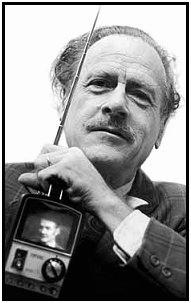 When one thinks of Herbert Marshall McLuhan—literary scholar, communications theorist, extraterritorial celebrity, famed cameo extra in a Woody Allen movie—Roman Catholicism doesn’t necessarily spring to mind. Not that his many biographers and commentators have avoided the subject; indeed, McLuhan’s Catholicism surfaces not infrequently in their writings, usually to be marginalized or vilified, or at least explained away. The prevailing versions of McLuhan as Catholic include: ardent convert and regular communicant; heir to the triumphalism of G. K. Chesterton (this charge is unfair, especially to Chesterton); a religious reactionary opposed to the Second Vatican Council; an Evelyn Waugh wannabe, lamenting the destruction of the Old Religion; an apocalyptic visionary or Catholic Cassandra avidly chronicling the end days. And on and on.
When one thinks of Herbert Marshall McLuhan—literary scholar, communications theorist, extraterritorial celebrity, famed cameo extra in a Woody Allen movie—Roman Catholicism doesn’t necessarily spring to mind. Not that his many biographers and commentators have avoided the subject; indeed, McLuhan’s Catholicism surfaces not infrequently in their writings, usually to be marginalized or vilified, or at least explained away. The prevailing versions of McLuhan as Catholic include: ardent convert and regular communicant; heir to the triumphalism of G. K. Chesterton (this charge is unfair, especially to Chesterton); a religious reactionary opposed to the Second Vatican Council; an Evelyn Waugh wannabe, lamenting the destruction of the Old Religion; an apocalyptic visionary or Catholic Cassandra avidly chronicling the end days. And on and on.
But McLuhan’s Catholicism is not so neatly categorized. Faith was profoundly constitutive of the life and thought of this Canadian genius, outsider, and seer, and in this hundredth anniversary year of his birth, it deserves a fuller exploration. From the outset, McLuhan’s reasons for conversion differentiated him from the conventional intellectual. Consider his account of his conversion. Years later he would describe being asked, by someone who had listened to him talking, why he wasn’t a Catholic. “I couldn’t think of one reason,” he would recall. “I was beat. I became a Catholic at once, because I knew that was the divine work.” He went on to add the kicker: “By the way, faith is not a matter of concepts: it’s percepts, a matter of immediate reality.” McLuhan’s conversion, in other words, was driven by the unexpected suddenness of truth and the unassailable awareness that what was being given by the Catholic Church was in the end beyond the rigors of argumentation or the seductive power of well-honed apologetics; that its core moment was reducible simply to getting down on your knees and asking for the truth. Which was what McLuhan did. The date was March 25, 1937. Marshall McLuhan was twenty-five years old.
Instrumental in his conversion were Chesterton, whose maxim—“Let your religion be less a theory and more a love affair”—McLuhan took to heart; Aquinas; and the Praeses of the Pontifical Institute of Medieval Studies in Toronto, Gerald Phelan. These were orthodox mentors, for sure, and their orthodoxy informed McLuhan’s attachment to the high importance of ritual and his personal commitment to attend the Eucharist frequently. But while McLuhan’s commitment to devotion and doctrine followed a traditional bent, his research in the area of communications technology would result in some tantalizing, even subversive, thinking in the area of ecclesiology.
Armed with a doctorate from Cambridge University in 1943 (his dissertation in English literature was “The Place of Thomas Nashe in the Learning of His Time”), McLuhan went on to work in various Catholic institutions of higher education: St. Louis University; Assumption University (later secularized as the provincial University of Windsor); and the University of St. Michael’s College in the University of Toronto, the Basilian-sponsored academy where he would spend the balance of his career, retiring in 1979 following a catastrophic stroke. (Even his sabbatical years were spent in Catholic circles, including a 1967 stint as Albert Schweitzer Professor of Humanities at Fordham.) His research in the area of Renaissance rhetoric and our technological environment resulted in a series of astonishingly innovative publications: The Mechanical Bride: Folklore of Industrial Man (1951), The Gutenberg Galaxy: The Making of Typographic Man (1962), Understanding Media: The Extensions of Man (1964), and The Medium is the Massage: An Inventory of Effects (1968). These works were in many ways disturbingly opaque—at least, that is, for those unwilling to adjust to McLuhan’s syntactical wizardry, love of neologisms, and shatteringly original probing into the nature of the media.
McLuhan was direct, even brutally blunt, when expressing his dismay over the myopia of his colleagues, and he did not spare churchmen in the process. “The degree of literacy within the Catholic Church,” he wrote, “is very low indeed.” How low? About “on the Reader’s Digest level.” He saw no great danger in that: “It is just a bit of a disgrace, like having one’s fly open in public.” One needs to understand, of course, that by literacy and culture McLuhan meant far more than reading books. His primary and foundational thesis—that the world of modern communications, introduced with the invention of the telegraph in the nineteenth century, is characterized by simultaneity and immediate transformation—had massive implications for politics, commerce, social stability, education, and interpersonal communication. No longer would it be possible to operate by the old certitudes when bureaucracies are disassembled at the speed of light, and the instantaneity proffered by the new media (the advent of the Internet lay just around the corner) ensures the reshaping of the sensorium. The ear, and no longer the eye, was now in the ascendant; the world fashioned around print had been superseded.
The consequences for Catholicism and the church were large. In McLuhan’s view, the emergence of print had boosted the populism of the Reformation and shattered irretrievably the hegemonic control hitherto maintained by the Holy Roman Church. This did not mean, however, that Catholicism eschewed the new avenues of transmission, nor that it avoided the centralizing and bureaucratic tyrannies of print. The Roman hierarchy after Gutenberg, McLuhan wrote,
had acquired a great deal of the organizational-chart patterns of specialism and rigidity. Improved written communication made possible the development of a huge Roman bureaucracy, transforming the Roman pontiff into a chief executive. Further improvements in travel and communication brought the pontiff into more immediate personal relation to his subjects.... What, therefore, is called the de-Romanization of the Roman Church is quite simply its electrification. When things speed up hierarchy disappears and global theater sets in.
Catholicism in its “centralized, administrative, and bureaucratic form,” he concluded, “is certainly irrelevant.” Yet if McLuhan was disposed to cast the dicasteries into the dustbin of history—a wish privately cherished by many a bishop hungering for more than a morsel of collegial governance—he was not disposed to diminish in any way the power, prestige, and prerogatives of the Petrine primacy. Indeed, if the church’s “massive centralized bureaucracy” was obsolete, then the necessity of the pope’s ubiquity was all the greater. “I think today that we have to say that it’s the pope’s spoken word that counts, the word that he utters, not the encyclical,” he wrote. “In the electric age, live speech comes back to its own: it no longer needs to be hardened into documents.” McLuhan envisioned a teaching authority unhindered by text; an ecclesiastical voice without its centuries-old embodiment; a virtual kerygma.
McLuhan died in 1980, just two years into the pontificate of John Paul II, and had he lived longer he would have seen both an unprecedented outpouring of printed papal words and an adroit mastery, by a charismatic leader, of the power of a personal presence transmitted simultaneously to all parts of the globe. Paradoxically, John Paul demonstrated the capacity of the papacy to exist outside the constraints of bureaucracy—even as his contemporaries witnessed an expansion, and not a diminution, of centralized management.
McLuhan’s benign reading of the “de-Romanization” of the Roman Church reflected his unbending conviction—he was as orthodox on doctrinal matters as his contemporary and fellow convert Dorothy Day—that wherever Peter is, so is the ecclesia, and the gates of hell will never prevail against it. We can therefore, with little fear, dispense with the curia, holding on to the magisterium but refashioning its mode of authoritative delivery, and ensure the maximal presence of the pope in the new electric era. In so doing, we actually strengthen Rome’s evangelization strategies while uncoupling them from its visceral adherence to Eurocentrism. McLuhan’s hard-headed assessment of the impact of technology on human wiring did not preclude a romantic’s sensibility and a taste for the fantastic. And there is certainly something fantastic in the notion that the Roman curia will dismantle itself.
It was hard to imagine Benedict XVI taking kindly to such a radical departure from continuity—or, for that matter, most Catholics, accustomed to a structure deeply embedded in the old technological universe. McLuhan’s son Eric, who coauthored The Laws of Media with his father and remains the true heir of his legacy, recognizes that his father’s radical ecclesial vision has engendered not so much resistance as incomprehension. Eric has called for a Vatican Council III, “to deal with shedding the bureaucratic and administrative apparatus that the church accumulated in response to the alphabet and to print.” Surprisingly, that very apparatus has invited him regularly to its head office on the Tiber, to address symposia sponsored by the Pontifical Council for Culture and the Vicariate of Rome on a “Catholic theory of communications” greatly dependent on his father’s insights.
McLuhan himself disavowed being a theologian, insisting that any theological fine-tuning be left to the experts. One such expert was his old friend and St. Louis University colleague, the Jesuit scholar Walter Ong. Author of the influential Orality and Literacy: The Technologizing of the Word, Ong was once asked whether, if Jesus were alive now, he would use television. “Truth is personal,” Ong replied elliptically. “We communicate truth not simply by means of verbal and written communication but by means of our pauses, our silences. Jesus is the Way, the Truth, and the Life: he communicated himself and that is where the truth is.” And that is where McLuhan in the end comes full circle: back to the truth he approached on his knees in 1937.
Please email comments to [email protected] and join the conversation on our Facebook page.
Previous Story
The cardinal’s book; bargain issue
Next Story
All Told?

